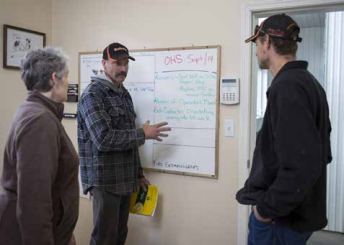How can I prevent injuries?
By taking steps to improve health and safety in your workplace, you can help prevent the human and financial costs that result from work-related injuries and diseases.
Occupational Health and Safety Regulation
The Occupational Health and Safety Regulation and the Workers Compensation Act set out health and safety requirements that must be followed by all workplaces covered under Part 3 of the Act, which includes most small businesses. Many sections of the Act and the Regulation also have associated guidelines and policies that will help clarify your requirements.
You can search the Act, Regulation, guidelines, and policies at worksafebc.com/searchable-regulation. For example, to get information about smoking at work, you can enter the search term smoking and then select the relevant sections that mention smoking.
You can also use the OHS Regulation mobile app, available for iOS and Android devices. The app allows you to search and browse the Act, Regulation, policies, guidelines, and WCB Standards on your mobile device.
Health and safety program
All workplaces, including small businesses, are required to have an occupational health and safety program to prevent work-related injuries and diseases.
Whether you need an informal or formal program will depend on the size and risk level of your workplace. A formal health and safety program should include the following:
- A process for identifying, assessing, and controlling hazards
- Written safe work procedures and emergency response procedures
- Orientation, education, training, and supervision for workers
- Regular inspection of your workplace, tools, equipment, and work practices and procedures to prevent the development of unsafe working conditions
- Incident investigations to identify causes and prevent recurrences
- Regular health and safety meetings that include workers
- Up-to-date records and statistics, if applicable (for example, documentation of training activities, first aid treatments, safety discussions, safety inspections, and incident investigations)
- A joint health and safety committee or a worker health and safety representative, as applicable
See sections 3.1 to 3.3 of the Regulation to find out what's required for your workplace.
First aid requirements
Employers are required to determine the level of first aid supplies, attendants, and services appropriate for their workplaces by conducting a first aid assessment. See Schedule 3-A (Minimum Levels of First Aid) in the Regulation to determine the specifics for your workplace.
Involve your workers in health and safety
Encourage your workers to ask questions if they do not understand something, especially if they are young or new to the job. A few minutes spent explaining or re-explaining something could prevent a costly incident. Make sure your workers know the following:
- Their rights and responsibilities, including the right to refuse unsafe work
- How to perform tasks safely
- Who to ask if they have questions or need more training
- Where to get first aid if they are injured
Depending on the size of your business, you may be required to develop and implement written safe work procedures. This is a good practice even if you are a smaller business since it gives workers something to refer to if they are unsure of what to do. Take the time to ask your workers how they would improve productivity and safety. Encourage workers to participate in and take ownership of initiatives.
Address worker concerns quickly
As a small business, you have the advantage of being able to hear concerns directly from your customers and your workers. You can also deal with concerns more quickly and resolve many issues immediately. Listen to your workers' concerns about health and safety, and provide them with feedback on their safety performance. Deal with health and safety issues, such as broken equipment, as quickly as possible.
Bullying and harassment in the workplace
Bullying and harassment in the workplace can take many forms, including verbal aggression, personal attacks, and other intimidating or humiliating behaviours. If workplace bullying and harassment is not addressed, it can lead to lost productivity, anxiety, and depression.
As an employer, you must develop and implement procedures for responding to reports or incidents of workplace bullying and harassment. These procedures must include the following:
- How and when investigations will be conducted
- What will be included in the investigation
- The roles and responsibilities of employers, supervisors, workers, and others (such as investigators, witnesses, or union representatives)
- Follow-up to the investigation (description of corrective actions, time frame, dealing with adverse symptoms, etc.)
- Record-keeping requirements
For more information on how to meet your occupational health and safety duties related to bullying and harassment, visit worksafebc.com/preventbullying.
We're here to help
Most likely there are other businesses similar to yours. Contact us to find out if there is an industry association for your type of business, or to learn more about common injuries in your industry and how to prevent them.
You can also access industry-specific health and safety resources on worksafebc.com.
Get information and assistance with health and safety issues in the workplace
Our Prevention Information Line is a phone service dedicated to health and safety in B.C. workplaces. You can connect for a one-on one consultation with a prevention officer and get answers to your occupational health and safety questions.
